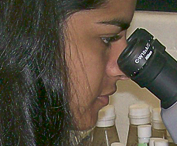 SPUR provides fellowships for more than twenty undergrads from the UO and other institutions to engage in intensive daily research.
SPUR provides fellowships for more than twenty undergrads from the UO and other institutions to engage in intensive daily research.
When she was a high school student with outstanding grades and sky-high ambitions, Alexandra Hartman was looking at exclusive liberal arts colleges and considered the UO her fallback if nothing else panned out. But then her high school adviser intervened.
“He said, ‘even though it’s your state school, it’s a research university. If you want a career in science, it’s here,’” Hartman said. “And I am so glad I took his advice.”
Among 4,600 U.S. universities, the UO is one of only 108 with the top-tier designation of “very high research activity” by the Carnegie Classification of Institutions of Higher Education. The UO hosts more than twenty research centers and institutes ranging from the physical and life sciences to the humanities.
Hartman is among the hundreds of young scientists on campus who avail themselves of meaningful research programs each year. One of the best (according to Hartman herself) is the Summer Program for Undergraduate Research, or SPUR.
Every summer, SPUR provides fellowships for more than twenty undergraduates from the UO and other institutions to engage in intensive daily research in life sciences laboratories. Students with limited income and other disadvantages are immersed in rigorous, high-profile projects under the direction of research professors from biology and other disciplines.
Hartman, who studied brain behavior under Michael Wehr, an assistant professor of psychology, during SPUR 2010, went on to work in Wehr’s laboratory until graduating last spring and continues on in that lab as a research assistant.
“SPUR helped me link to a nationally funded principal investigator and a real lab where people are publishing research and doing new and exciting things,” said Hartman, who was covaledictorian for biology’s class of 2012 (see inside front cover). “You see just how hard research is, and that’s invaluable. It’s just not something you can get at a small, private school.”
SPUR students work full-time in the lab on cutting-edge research investigations, under the close supervision of “bench mentors” that include postdoctoral fellows, graduate students, lab technicians and faculty members.
Hartman studied how circuits in the cerebral cortex encode and transform sensory information, exploring how the brain “filters out” irrelevant data—i.e., the mechanism that allows you to hold a conversation without being distracted by the background music of someone playing a piano.
SPUR students come to the program with backgrounds as wide-ranging as biology, environmental science and psychology; their research has focused on subjects as diverse as craniofacial development, stomach cancer, climate change in the Pacific Northwest and the effects of total knee arthroplasty.
Students write progress reports that are updated weekly and reviewed by mentors, principal investigators and SPUR director Peter O’Day. They participate in laboratory discussions and are encouraged to present their work at a midsummer meeting.
Leading scientists from the UO and beyond also introduce SPUR students to pioneering research during a seminar series. UO speakers have included NIH “New Innovator” and neuroscientist Cris Niell and chemist Brad Nolen, a 2011 Pew Scholar.
“SPUR is very different from sitting in a biology lecture and being told, ‘this is what we know,’” said Karen Guillemin, one of last year’s faculty speakers and also director of the UO META Center for Systems Biology and a leading scientist on the interaction of bacteria and host cells. “SPUR students are being told, ‘this is what we need to know.’”
SPUR builds camaraderie through weekend outings to destinations such as the Oregon coast or Portland’s Oregon Museum of Science and Industry. Guillemin took things even further last summer: She held regular research discussions for her young team at Café Roma, a coffeehouse near campus; the students surprised Guillemin with what she called their “intellectual excitement,” exhaustively poring over each other’s research as they worked on communication skills and critical analysis.
The students end the summer-long experience with poster and oral presentations of research worthy of a national conference. Stellar work has emerged: Eight students from the 2012 program received national research awards at the annual Biomedical Conference for Minority Students in San Jose.
“We are very interested in enhancing the diversity and talent of the next generation of life scientists,” O’Day said. “SPUR provides spectacular opportunities for students to engage themselves in the life of a scientist and make career decisions based on a richness of information and authentic research experiences.”
—Matt Cooper


-thumb-200x200-1722-thumb-100x100-1723.jpg)


 From federal forest payments to the benefits of reading readiness, econ honors projects get real.
From federal forest payments to the benefits of reading readiness, econ honors projects get real. SPUR student receives prestigious Howard Hughes Medical Institute Award.
SPUR student receives prestigious Howard Hughes Medical Institute Award.